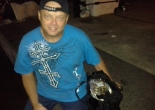
Transitional Artifacts
by Michael McFadden
Images courtesy of FreshArts and Michael McFadden
Houston’s rate of urban growth ranks among the highest in the nation, and as it continues to top numerous charts, becoming the best place to find work as well as the most diverse city in the United States, this rate is sure to increase. In turn, this growth has attracted a wide array of social, cultural, and economic interests. With each of these diverse interests trying to stake a claim in the city’s future, Houston is undergoing a very dramatic transformation. Currently on display at Fresh Arts, Transitional Artifacts is a six-week performative exhibition by The Center for Imaginative Cartography & Research that explores the by-products left in the wake of this change: the tearing down of buildings, piling up of waste, mashing together of historical and contemporary buildings, and public conflicts between opposing interests. As each of these fights to attain or retain influence on the identity of the city, The Center - a collaboration between artists Emily Halbardier and Erik Sultzer - offers a space for reflection on this transformation.
Local residents have had their own experiences with this transformation, and it’s something these artists have witnessed themselves.
“In the area we live in,” said Halbardier, “older houses are being torn down, and the newly constructed home will often go right to the edges of the property.”
The areas you could once walk around to enjoy the subtle differences between houses and their owners’ individual tastes in landscaping, architecture, and decorating, are now interrupted by construction sites and large concrete walls that “protect” the property from outside influence. It can be seen across the country: Cities renew, tear down, and rebuild with an apparent disinterest in maintaining the historic as people and families are displaced. It’s cold, logical, and fully natural for any growing city. Those being displaced refer to it as gentrification; the developers raising these new homes call it revitalizing the city’s urban core. Personal views aside, there’s no denying how much waste is produced.Within this transformation, the artists from The Center have found a goldmine. Equal parts installation and performance, Transitional Artifacts is an exhibition that changes with each visit.
“The impetus for this project wasn’t so much the actual change, growth, and transformations of Houston, but rather the vast amount of excess and waste,” said Halbardier. “Every new construction [site] has a dumpster in front of it filled with wood and concrete and cardboard and other usable materials. We document the way these materials are piled up because they motivate and inform our work. The piles become sculptural objects for us to revisit and possibly recreate.”
As the artists explore these sites and collect detritus from around the city, they reorganize the space to create new visuals. Some elements of the show are worked by the artists; some are raw; and some pass between states as the exhibition continues.
“When a viewer enters the space [and we aren’t there working], she is confronted by a collection of objects and images. These visuals have been taken from the local area and placed into the gallery space,” said Sultzer.
This performative facet of the installation challenges visitors to rethink the idea of an art show in its most basic principles (What is an art show? What can an art show be?) and discover the various ways in which space can be used. Throughout the run of the exhibition, the artists invite the Houston community to visit the space and engage it alongside the artists. They have provided (and plan to have more) opportunities for people to visit and engage with the space while they are there.
“We want people to come in and have a seat,” said Halbardier “Take their shoes off and lay on a quilt. Have the gallery be a space where women can get together and craft and talk. Where movies can be screened, a dinner party take place, a yard sale can happen.”
As visitors move through the space, taking in the objects, they find themselves asking the same questions the artists asked. What are these objects? How do they relate to another? How do they communicate with each other? Without a narrative in place, it’s difficult to determine how satisfying the installation is to anyone walking in blind, and Sultzer acknowledges this.
“The installation does not offer straightforward consumption, or easy summarization, or a position where the viewer can ‘take it all in.’ The performative aspect is neither entertaining nor dramatic.”
Still, while the exhibition lacks a distinct narrative, it becomes oddly comforting. Visitors are surrounded by objects that were discarded by displaced individuals and families, and these objects give the space a homey feel. Yet, the next visitor might have a completely different experience once the artists have added to, subtracted from, or simply rearranged the space. Transitional Artifacts doesn’t offer easy answers.
“While we might be upset at the kind of change and growth that is taking place, the art that we make does not directly reflect this,” Halbardier said.
She explained further that this exhibition is not meant to teach, convince, or rally viewers into sharing their perspective. It provides a reflection on observations made during a dramatic transformation in Houston’s landscape and the continued production of waste and excess. By physically engaging the waste and excess, the seed for this installation was planted and has produced a space that affords visitors the opportunity to engage the excess and waste. Although the exhibition does not offer a stance or argument for either side of this issue, it gives visitors the opportunity to join the artists in their creative inquiry.
“We are asking questions,” they said.“We are asking viewers, also, to ask questions.”





You must be logged in to post a comment Login